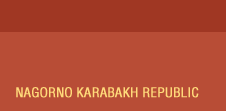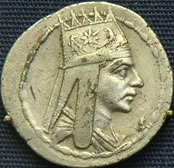
Tetradrachma of Tigran II the Great, King of Armenia (ruled 95 BC–55 BC),
with an image of Tigran wearing the Armenian Crown (Armenian royal tiara).
|
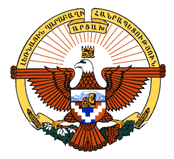
Coat of Arms of the Nagorno Karabakh Republic featuring the Armenian Crown. The Crown points to Nagorno Karabakh’s connection to the dynasty of Hasan-Jalalians whose ancestry included kings and nakharars of the ancient Kingdom of Armenia.
|
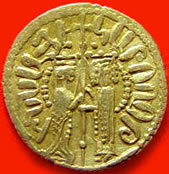
An Armenian-inscribed golden coin of King Hethum I of the Armenian Kingdom of Cilicia (reigned from 1226-1270). Grand Prince Hasan Jalal Vahtangian, the patron of the Gandzasar Monastery, helped King Hethum I establish ties with the Mongols.
|

The Wheel of Eternity, an Indo-Aryan symbol, curiously placed inside the Star of David: a carving on the marble tombstone of Grand Prince Hasan Jalal Vahtangian, Lord of Khachen (1431).
|
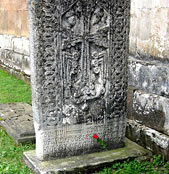
Gandzasar’s largest khachkar (memorial cross-stone) serving as tombstone of Grand Prince Hasan Jalal Vahtangian’s daughter Hatun. The inscription in Old Armenian reads: “I, Hasan, son of Vahtang, erected this cross [in memory of] my daughter Hatun, and on behalf of her mother, the Queen—daughter of the King of Baghk.”
|
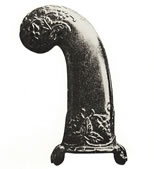
Nephrite-incrusted and Armenian-inscribed hilt of Grand Prince Hasan Jalal Vahtangian’s personal dagger is on display at Russia’s Hermitage museum. The inscription reads: “Hasan Jalal, Prince of Khachen.” Photo by Boris Baratov.
|

Hasan-Jalalian descendants today. From left to right: Henrik A. Poghosian (1930-2000), who led the Nagorno-Karabakh Autonomous Oblast toward secession from Azerbaijan in 1988 and became the first-ever official in the USSR elected by popular vote; Levon G. Hairapetian, Russia-based businessman and philanthropist who helped restore the Gandzasar Monastery; Jasmen H. Asryan, Armenia-based writer, actress and politician.
|
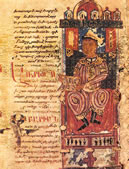
Portrait of Prince Vahtang by artist Toros. Vahtang was Grand Prince Hasan Jalal Vahtangian’s grandson (the child of Asan’s daughter, Princes Mama, and Umek). He was tutored by the famous Armenian literary figure Hovhannes Erzynkatsi (1230-1293), and hence is shown with a book in his hands. Source: Hakopian, Hravard. The Miniatures of Artsakh and Utik: 13-14 Centuries. Yerevan, 1989; Gospel (MS 155). The original is kept at Matenadaran—Institute of Ancient Manuscripts (Yerevan, Armenia).
|


